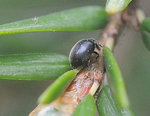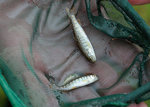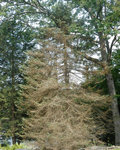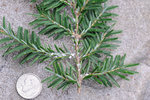 Narrowsburg
NarrowsburgLight Rain Fog/Mist, 43°
Wind: 8.1 mph
 Narrowsburg
NarrowsburgThe next time you walk to your favorite trout stream to fish, take notice of the different habitats that you pass through. If you had to walk any distance from the stream, you may well have seen a …
Stay informed about your community and support local independent journalism.
Subscribe to The River Reporter today. click here
This item is available in full to subscribers.
Please log in to continue |





The next time you walk to your favorite trout stream to fish, take notice of the different habitats that you pass through. If you had to walk any distance from the stream, you may well have seen a habitat of mostly deciduous forest. There will likely be some understory present, such as mountain laurel, huckleberry, or even some hay fern covering some of the clearer areas. As you get closer to your fishing spot, however, you will notice that you are walking downslope into the stream gorge; at the same time, the habitat changes from a deciduous forest of oaks and some maples to a coniferous forest consisting of hemlocks and white pine. The gray squirrels that you saw in the tree next to the parking area is now replaced by red squirrels, scolding you for interrupting their breakfast of pine seeds.
The eastern hemlock in the region tends to grow in these stream gorges and create its own micro-climate, as hemlocks create an abundance of shade. This is a good thing for a stream that supports a cold-water fishery such as trout. The threat to the eastern hemlock and some of these cold-water fisheries come in the form of a tiny insect called the hemlock wooly adelgid (Adelges tsugae).
The hemlock wooly adelgid (HWA) is a very small and aphid-like insect of the order Hemiptera (true bugs). An invasive species from Asia, they were first seen in Virginia in 1951 and gradually expanded their range northward. The HWA gets its name from the small fuzzy white egg masses that the female produces. The juvenile insects use their mouthparts to penetrate the needles of the hemlock and feed on the starches of the host tree, thereby damaging the hemlock. Each female can lay up to 300 eggs; they are capable of laying eggs twice per year. Unchecked, an infestation can kill a mature hemlock in 10 years.
The first signs of infestation include the presence of the fuzzy egg masses, usually in the underside of a needle bearing branch. Most of the masses are seen at the base of the needles. Later, extensive loss of needles may be seen, or needles that are gray in color. If enough loss of needles occurs, the tree dies.
To understand the implications of an HWA infestation, we may want to look at how climate change has affected the spread of this pest, and to consider future implications. A heat wave or a cold snap over the period of a couple years does not a trendline make; however, if our climate gets warmer over the long term, the loss of hemlock stands along the cold-water streams will likely have a negative effect on the trout habitat. According to a report by the New York State Energy Research and Development Authority on the possible impacts of climate change in New York State, “extensive loss of hemlock forests will have cascading, far-reaching effects on a variety of wildlife species and their ecosystems.”
One factor now that suppresses HWA and aids in slowing its northern spread is extreme cold. Studies have shown that temperatures below -5 degrees can kill a majority of wooly adelgid larva on hemlock trees. Our region’s HWA population seemed to be impacted due to several sub-zero nights in January of 2018, a temporary respite for the hemlock trees.
The HWA also has a handful of natural predators; most of them are other insects. One in particular has been imported and released in forests in several states. Sasajiscymnus tsugae, a member of the ladybeetle family, is a small black beetle, barely 2mm long. Some private landowners have arranged releases of beetles with some success. More on this biological control of HWA can be found in the May 10, 2017 River Talk column, found here: www.bit.ly/hemlockattackers.
In addition, some stands of hemlock seem to be more resistant to HWA. Wayne County Conservation District Forest Specialist Kelley Stewart had reported to its board members in February that there is a stand of HWA-resistant hemlock trees in the Wallenpaupack area. Called “lingering hemlocks,” these particular hemlocks have been found to contain an increased concentration of terpenes in their twigs and needles. Terpenes are a class or organic compounds that are aromatic and present in many plants. Increased concentrations of terpenes have been found to be toxic to HWA. Other stands of HWA-resistant hemlocks exist in and out of the region.
During my own trips into forest habitat in the last year or so, I have seen little or no infestation of HWA in areas where it was present in the past. This is strictly an anecdotal observation, since most of the time, I was not looking for HWA. Perhaps it could be due to the severe cold of 2018. Time will tell if HWA areas decrease due to biological controls, or another predator or parasite that may appear, similar to the pathogens that affected gypsy moth caterpillars of recent years.
Anglers can help by reporting new infestations to your state or local forestry agency. In NYS, an online form is available at www.bit.ly/hwanynotify. robins at rest. Tune in to watch various species at www.allaboutbirds.org/cams/all-cams.
Comments
No comments on this item Please log in to comment by clicking here